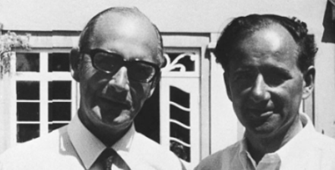 There are many ways of discovering effective medicines. One can, for example, investigate herbal remedies, endogenous agents in animals and micro-organisms, or drug metabolites; use applied pharmacology and empirical chemistry; or implement rational design based on a target or pathophysiology. Not infrequently chance plays a part, as in the case of lithium.
There are many ways of discovering effective medicines. One can, for example, investigate herbal remedies, endogenous agents in animals and micro-organisms, or drug metabolites; use applied pharmacology and empirical chemistry; or implement rational design based on a target or pathophysiology. Not infrequently chance plays a part, as in the case of lithium.
Two hundred years ago, in 1817, Johann August Arfwedson (1792–1841), working in Sweden in the laboratory of Jons Jakob Berzelius (1779–1848), studied the properties of a feldspathoid mineral ore called petalite, which a Brazilian chemist and statesman, José Bonifácio de Andrada e Silva (1763–1838), had discovered in 1800 on Utö Island, off the coast of Sweden. The IndoEuropean root PETƏ, to spread, gives us words such as petal, patent (Latin patens, broad, wide, lying open), expand, patella, passage, passim (throughout), and patina (Latin, a broad shallow dish or pan, perhaps from the film that forms in a copper pan after prolonged use). Petalite gets its name from its leaf-like cleavage structure (Greek πέτᾰλον, a leaf).

Petalite is mostly composed of insoluble lithium aluminium silicate, but it also contains small amounts of the soluble alkaline salt lithium oxide, which Arfwedson extracted. He and Berzelius called it lithion, from the Greek λίθος, stone, because of its mineral origin; it was later called lithia, and the pure metal was called lithium. Berzelius described Arfwedson’s discovery in a letter to the Journal für Chemie und Physik dated 27 January 1818, under the title “Ein neues mineralisches Alkali und ein neues Metall”.
In 1821 the English chemist William Thomas Brande (1788–1866) obtained lithium by electrolysis of lithium oxide, the process that Humphry Davy had used to isolate the alkali metals sodium and potassium, and in 1855 lithium was prepared in sufficient quantities by electrolysis of lithium chloride for its properties to be investigated by Robert Bunsen and Augustus Mathiessen.
In 1843 the Scottish physician and chemist Alexander Ure (1778–1857) used lithium carbonate to dissolve bladder stones, and lithium salts were also used to treat gout and other diseases, such as epilepsy, migraine, rheumatism, eczema, diabetes mellitus, Bright’s disease, and gallstones, all thought to be related to a “uric acid diathesis”. Lithium chloride was used as a salt substitute in the US, under brand names such as Foodsal, Milosal, Salti Salt, and Westsal; cases of lithium toxicity led to the withdrawal of all such products from the market.
AB Garrod treated gout with lithium and proposed that uric acid might affect the brain, so called “brain gout”, which might be related to some forms of depression. In the late 19th century the American neurologist William Hammond, among others, used lithium bromide to treat bipolar depression; perhaps the sedative effects of the bromide were useful.
Lithium was then forgotten and rediscovered in the 1940s by John Cade, an Australian psychiatrist. Mania is associated with hyperthyroidism and depression with hypothyroidism, and so Cade thought that bipolar affective disorder, as we now call it, might be due to some abnormal endogenous substance. He found that urine from affected patients was more toxic than urine from controls when injected into guinea pigs, who died from urea toxicity. Because the urinary urea concentrations were the same in the two groups, Cade thought that something else in the patients’ urine enhanced urea toxicity. Choosing uric acid as a candidate he investigated the effects of a combination of urea and a urate salt, using lithium urate because of its solubility. Lithium urate reduced the toxicity of urea, but later experiments with lithium carbonate showed that it was the lithium and not the urate that was effective. Cade took some lithium himself without adverse effects and then gave it to 10 patients with mania, seven with schizophrenia, and three with depression; the response in those with mania was excellent.
The use of lithium carbonate in manic states was then noted in editions of Martindale’s Extra Pharmacopoeia, but even as late as 1965 the third edition of The Pharmacological Basic of Therapeutics by Goodman and Gilman pleonastically stated that “lithium has no known biological role as far as is known”, while noting Mogens Schou’s 1954 paper on its efficacy in manic depressive psychosis. Schou’s publication list includes nearly 200 items on lithium.
So the story of the discovery of lithium as a therapeutic agent is one of chance findings, forgetfulness, faulty hypotheses, and persistence in the face of skepticism.

John Cade (left) and Mogens Schou
Jeffrey Aronson is a clinical pharmacologist, working in the Centre for Evidence Based Medicine in Oxford’s Nuffield Department of Primary Care Health Sciences. He is also president emeritus of the British Pharmacological Society.
Competing interests: None declared.
